The Air War Over Germany & Japan
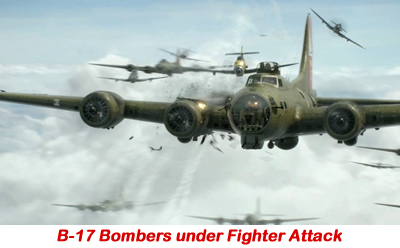
The Origins: Airplanes in the Great War. Airplanes became a part of warfare during the First World War as part of the industrialization of the battlefield. At the end of the war in 1918, aerial combat was still in its infancy, but a glimpse of the future of air power was seen in the limited bombing raids conducted by the British, French, and Germans. Early in the war airplanes were little more than valuable reconnaissance tools. Before long machine guns were placed in 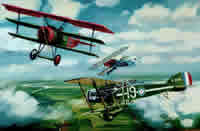 airplanes, and pilots began strafing targets on the ground. For a time bombing missions consisted of nothing more than pilots throwing grenades or other explosive devices out of the cockpit by hand. But eventually more sophisticated means of delivering ordinance were added to aircraft. Despite these advances, aircraft, like tanks, had yet to become dominant factors on the battlefield.
airplanes, and pilots began strafing targets on the ground. For a time bombing missions consisted of nothing more than pilots throwing grenades or other explosive devices out of the cockpit by hand. But eventually more sophisticated means of delivering ordinance were added to aircraft. Despite these advances, aircraft, like tanks, had yet to become dominant factors on the battlefield.
World War I, however, did provide a huge impetus to the development of aviation. Charles Lindbergh’s famous flight across the Atlantic in 1927 was a milestone, but real advances in aircraft design and manufacture began to appear in the 1930s. Aircraft engines became far more powerful; aircraft bodies were made of metal rather than wood and cloth; aerodynamic features were incorporated into designs, giving aircraft greater speed, maneuverability, and range; aviation fuels and lubricants were improved, and some of the world’s most famous and durable aircraft, such as the Douglas DC-3, were developed during the 1930s. Brilliant engineers such as Howard Hughes pushed the capabilities of airplanes to new limits.
All the major nations—the United States, France, Germany, Russia, Japan, Great Britain, Italy, and others—poured millions of dollars and thousands of hours of research into aircraft development. Although much of that work was devoted to creating aircraft for carrying passengers or mail over ever-longer distances, aircraft were also being widely developed for military use. By 1940 large, powerful multi-engine aircraft were capable of carrying thousands of pounds of armaments and bombs over the battlefield. The B-17 Flying Fortress was one such airplane.
Theories of Air Power. Although the effect of aircraft on the progress of the first world war was less than decisive, the possibilities of air power became apparent. The use of airplanes on the battlefield provided a dimension of warfare that had not existed before, namely, the ability to carry the battle beyond the front lines to attack the enemy directly from the new direction. The horrible carnage caused by the stalemate in the first world war led to a considerable amount of theorizing about different strategies to avoid repeating that gruesome situation. One important theory, that of the indirect approach, was developed by Sir Basil H. Liddell Hart, an important British military thinker. His basic argument, based on tactics going back to the Civil War, was that attacking a powerful enemy had on would lead to more of the same; better, he argued, to find a way around those defenses and attack from another direction. Air power was naturally adaptable to that purpose.
Between the wars a considerable amount of research was done on the use of air power. U.S. Army General Billy Mitchell, who would commanded US air forces 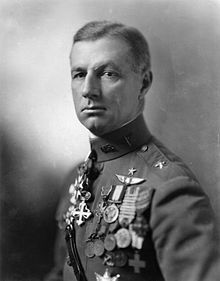 in World War I, had some revolutionary ideas about air power. He argued, for example, the aircraft for a more effective weapon friendships, and that even heavy battle cruisers could be destroyed from the air. Testing the theory captured World War I warships suggested that he was correct. Mitchell argued forcefully enough for his theories that he was accused of insubordination and eventually court-martialed, but his ideas were validated during the second world war.
in World War I, had some revolutionary ideas about air power. He argued, for example, the aircraft for a more effective weapon friendships, and that even heavy battle cruisers could be destroyed from the air. Testing the theory captured World War I warships suggested that he was correct. Mitchell argued forcefully enough for his theories that he was accused of insubordination and eventually court-martialed, but his ideas were validated during the second world war.
Italian General Giulio Douhet also had some theories of air power that he published in his book The Command of the Air. New York: Coward-McCann, 1942. He argued that with the use of air power, “decisive blows will be directed at civilians, that element of the countries at war least likely to sustain them.” That notion would be heavily tested during the second world war, but it was clear is carrying offensive power deep into enemy territory could have destructive effects, not only on military matériel, but also on civilian morale. Until the use of atomic bombs led directly to the surrender of Japan, the notion that civilian morale could be damaged, thereby undermining nation's will to continue the contest, remained in doubt.
The theories that were developed between the wars led to one basic conclusion: air power wartime has two basic roles, strategic and tactical. Tactical air power is the use of airplanes in direct support of ground operations. Using aircraft for reconnaissance of any positions, followed by attacks with bombing and strafing not only to inflict casualties but to undermined enemy morale became an important concept of the use of air power. The Marine Corps developed a concept of close air support and procured aircraft directly suited to that role. The Army air forces also devoted a substantial portion of their air power development to that cause.
The use of air power as a strategic weapon follows the theory of General Douhet. Long-range bombers can deliver attacks against German industrial and population centers to damage factories and other facilities used to produce military weapons and provide oil and other necessary supplies for the support of armies on the front line. The German Luftwaffe showed the contrast between the two concepts in its attempts to conquer Great Britain. Tactically, German air power was meant to neutralize British defenses against the planned invasion, an attempt that was thwarted by the RAF in fending off German attacks. When that attempt to prove ineffective, the Luftwaffe then turned to what became known as the blitz of London, bombing not only London but other British cities in hopes of undermining British morale. In that case the idea backfired, as British backbones stiffened under the attacks.
Strategic air power was used intensively against both Germany and Japan during the course of World War II, culminating in attacks late in the war in cities like Dresden and Tokyo, both of which resulted in huge civilian casualties and extensive damage to the cities themselves.
World War II: Air Warfare Comes of Age. When the World War II in Europe began in 1939, the Armed Forces of all the nations involved had been building fleets of combat aircraft for some time. Fighters, fighter-bombers, dive bombers, and long-range medium and heavy bombers were parts of the assembled air arsenals. Early in the war, use of the airplane in direct support of ground troops was seen as an acceptable and logical extension of other battlefield support weapons such as artillery, machine guns, and tanks. But the use of airplanes against nonmilitary targets was at first approached gingerly by all sides. Early in the war care was taken to avoid even accidentally striking civilian targets, but that soon changed. Very early in the conflict an uproar resulted when a few stray bombs landed in a schoolyard not far from a factory, but when the German Luftwaffe bombed cities such as Warsaw and Rotterdam, the dynamics of air warfare began to change. Following the Battle of Britain, Air Marshal Hermann Goering commenced what became known as the blitz of London, and the use of bomber aircraft against civilian targets came into widespread use. The resulting devastation was enormous.
The Air War over Germany: Cities Become Targets
As the German army became more deeply mired in its campaign against the Soviet Union, British and American air forces undertook a massive air campaign against Germany that accelerated from 1943 through 1945. In May 1943, the first thousand-plane raid was conducted against the German city of Cologne, and all that was left standing in the heart of that old city was a huge Romanesque cathedral that had been strong enough to withstand the bombings. The cloud of smoke and ashes arising over the city of Cologne was visible from as far away as the English Channel. Hundreds of civilians were dead, and casualties numbered in the thousands.
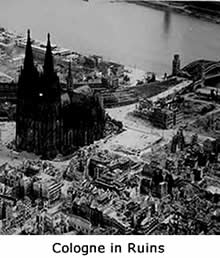 As the air war progressed, the British and Americans developed detailed strategies for attacking Germany’s war-making capability. The use of radar and other navigation devices and improved bomb-sights were meant to increase the accuracy of air attacks, but a combination of weather, German fighters, antiaircraft guns, and ordinary human error left bombing accuracy a goal to be desired rather than a real accomplishment. Bombs often fell miles from their targets, and sometimes even the wrong cities were attacked. For example, one squadron that was heading for Dresden in February, 1945, wound up instead bombing the Czech city of Prague.
As the air war progressed, the British and Americans developed detailed strategies for attacking Germany’s war-making capability. The use of radar and other navigation devices and improved bomb-sights were meant to increase the accuracy of air attacks, but a combination of weather, German fighters, antiaircraft guns, and ordinary human error left bombing accuracy a goal to be desired rather than a real accomplishment. Bombs often fell miles from their targets, and sometimes even the wrong cities were attacked. For example, one squadron that was heading for Dresden in February, 1945, wound up instead bombing the Czech city of Prague.
Priority targets for British and American pilots included aircraft plants, oil refineries, factories, transportation centers and facilities, military installations, and other war-related centers. But as German defenses were worn down and allied capabilities continued to grow, dozens of German cities were bombed more or less indiscriminately. In a raid on the city of Kassel, for example, the industrial targets received only minor damage whereas 90 percent of the city’s homes were hit. Toward the end of the war, raids that killed thousands of individuals occurred on a regular basis.
The Firestorm. The use of massive numbers of incendiary bombs together with high explosives soon created the most horrifying aspect of air warfare: the firestorm. When the conditions were favorable, conflagrations in concentrated areas within cities created strong drafts of wind as oxygen was drawn in to the center of burning areas to feed the flames. Those drafts increased the intensity of the fires, and the winds that swept toward the center of the burning areas eventually reached gale force, strong enough to knock a fleeing human being to the ground or even draw them into the flames. The upper drafts and rising heat sucked oxygen out of the basements where people were huddled, and many victims of bombings crouched in basements and underground tunnels died by asphyxiation.Hamburg. The worst firestorm of the war took place in Hamburg in 1943. The attack began on July 24 and lasted for eight days and seven nights. By the time it was over almost 43,000 citizens were dead and 37,000 were wounded. Almost everything in the city was destroyed. The attacks used approximately 3,000 aircraft that dropped about 9,000 tons of bombs. The heat created by the firestorm was so intense that asphalt streets actually caught fire. As defense against fighters and flak attacks, lead airplanes dropped strips of tinfoil  known as window that confused radar defenses, allowing the bombers to hit their targets with greater accuracy.
known as window that confused radar defenses, allowing the bombers to hit their targets with greater accuracy.
The rubble created by explosive bombs clogged streets and prevented firemen from reaching the burning buildings. While the attacks did destroy a large number of factories and other industrial facilities, most of the casualties were civilians, including 7,000 children; an additional 110,000 children were orphaned. Despite the massive damage in the July 1943 raids, Hamburg was attacked by bombers an additional 70 times before the war ended.
An attack on the city of Pforzheim earlier in 1943 also produced a horrific firestorm. Of the 65,000 residents of Pforzheim, over 20,000 were killed, almost twice the death rate of the atomic bombing of Nagasaki in 1945. Although the attack occurred in winter, the intense heat was such that hundreds of victims jumped into a nearby river, where many of them perished.
In all, twelve German cities suffered attacks that resulted in firestorms. When conditions were right—wooden buildings closely packed in crowded downtown areas, with weather conditions that did not diminish effects—the raging fires created heat that did not dissipate for days. While many victims were burned to death, the majority were killed by asphyxiation or were poisoned by gaseous fumes that saturated underground bunkers and tunnels. Basement shelters became crematoria.
The Battle of the Ruhr. The Ruhr Valley, a heavily industrialized area of Germany, became a high priority target early in the bombing campaign. The industrial output of the Ruhr area included steel, coke and synthetic oil. The most famous plant was the Krupp armament works in Essen. During the five-month campaign, repeated attacks were mounted against Essen, Duisburg, Düsseldorf, Dortmund, Bochum, Wuppertal and other cities in the region. The city of Cologne was also considered part of the Ruhr area. During the battle two dams were also attacked in a mostly unsuccessful attempt to disrupt water and hydroelectric resources. The attacks did, however, seriously disrupt German 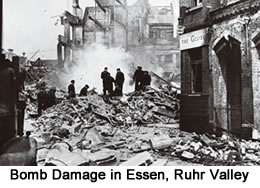 industrial production, including a 50% reduction in the output of steel. Although German Armaments Minister Albert Speer later claimed that no military equipment failed to reach the battle field on time because of the bombing, German industry suffered heavy blows from the air attacks.
industrial production, including a 50% reduction in the output of steel. Although German Armaments Minister Albert Speer later claimed that no military equipment failed to reach the battle field on time because of the bombing, German industry suffered heavy blows from the air attacks.
Attacks on the Ruhr Valley were carried out by both British and American heavy bombers such as the RAF Wellington and Lancaster and the USAAF B-17 Flying Fortress and B-24 Liberator. As they did through most of the war, the British flew night attacks while the American crews attempted what was called daylight precision bombing. For a variety of reasons, however, precision was often a goal to be desired rather than an achieved reality. Bombers sometimes missed targets by as much as 25 miles. During the night raids, pathfinders dropped incendiary bombs as markers and were followed by aircraft with explosive bombs. The incendiaries often started the firestorms, driving people into the streets where they became victims of "blockbusters."
The majority of the bombing of the Ruhr Valley was carried out by the RAF. The highest concentration of German anti-aircraft artillery was located in the Ruhr Valley; nevertheless, most of the losses to attacking bombers were from fighter aircraft. British crews sometimes referred to the Ruhr area as the "Valley of no Return."
Dresden. The most famous, or perhaps infamous, raid of the European war occurred at the city of Dresden in February 1945. The war was clearly winding down at that point as Russian armies were advancing in the East, and American, British, and French forces were rapidly approaching the Rhine and Germany itself. Dresden was a picturesque old city, sometimes called the Florence of the North, and 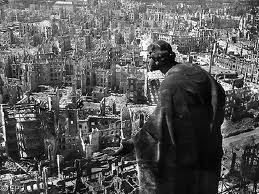 although it did have some minor military-related manufacturing, it was by no means an industrial city. Many of the antiaircraft defenses had been removed from the Dresden area to reinforce the cities in the Ruhr industrial region. Citizens of Dresden had come to believe that the city might be spared. They were wrong.
although it did have some minor military-related manufacturing, it was by no means an industrial city. Many of the antiaircraft defenses had been removed from the Dresden area to reinforce the cities in the Ruhr industrial region. Citizens of Dresden had come to believe that the city might be spared. They were wrong.
The city of Dresden had become clogged by tens of thousands of refugees fleeing from the advancing Russian armies to the east. The attacks on Dresden began at night when Mosquito bombers dropped thousands of incendiary flares on the city to mark it as a target for the following bombers, and to start fires throughout the city. Heavy British Lancaster and Haviland bombers followed, dropping tons of high-explosive bombs on the city. The following day, while the fires still raged, American B-17 aircraft flew over and dumped more tons of bombs on the city. Those daylight attacks were followed by yet more nighttime raids by British bombers.
By the time the raids had ended, Dresden lay in ruins, and thousands of civilians were dead, including many of the refugees who had wandered into the city seeking safety from the Russian advance. Although the exact numbers of casualties were impossible to determine, they numbered in the tens of thousands. Following the attack, the New York Times referred to the raids as deliberate “terror bombing.” After the war, the Dresden attack became a focal point for propaganda purposes against the Western powers.
Hundreds of books have been written about the European war; many of those have focused on the air war, and a number of them concentrate particularly on Dresden. Whatever justification for the devastating attack may have existed at the time, the legacy of the air war rightly or wrongly served as a propaganda tool for the Soviet-dominated Communist governments of Eastern Europe in the postwar period. Even Western writers such as Major General John F. C. Fuller have deplored what they called the excesses of the Allied bombing campaigns. Postwar peace and understanding, they have written, cannot be constructed upon piles of rubble and the graves of hundreds of thousands of people.
After the war studies were done to try to determine the overall effectiveness of the air campaigns of the Second World War. Different authorities have come to different conclusions, but a consensus seems to have determined that the costs of the air war to the victims significantly outweighed the benefits to the victors. Sadly, that lesson was difficult to absorb, as the massive bombings of North Vietnam during that conflict later demonstrated. (Web site on the B-17 Bomber)
The Tuskegee Airmen
A singular contribution to the Allied war effort in Europe was made by the Tuskegee Airmen, known as the Red Tails. Rarly in the war young college-educated African-American men were recruited for training as pilots, over the objections of racist voices that proclaimed that they could not handle aircraft in combat. The "Tuskegee Experiment" began, nevertheless, and the recruits were sent to the Tuskegee Airfield in Alabama to learn how to fly. (Several of the recruits aleady had civilian pilot licenses.) Their training as 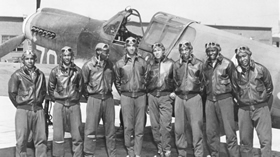 pilots was rigorous, and not all of them managed to finish flight school. But even under the command of white officers and white instructors, the Black airmen quickly proved that they could handle aircraft with no difficulty. Those who completed their training successfully wanted opportunity to participate in combat action, but at first it seemed as though they would be consigned to transport duty and not allowed to fly against the enemy. To quiet some of the objecting voices, First Lady Eleanor Roosevelt visited Tuskegee and was taken for a ride by one of the Black instructors. She got out of the plane smiling and announced that they surely could fly! The image to the left shows some of the flyers with one of their training aircraft at Tuskegee.
pilots was rigorous, and not all of them managed to finish flight school. But even under the command of white officers and white instructors, the Black airmen quickly proved that they could handle aircraft with no difficulty. Those who completed their training successfully wanted opportunity to participate in combat action, but at first it seemed as though they would be consigned to transport duty and not allowed to fly against the enemy. To quiet some of the objecting voices, First Lady Eleanor Roosevelt visited Tuskegee and was taken for a ride by one of the Black instructors. She got out of the plane smiling and announced that they surely could fly! The image to the left shows some of the flyers with one of their training aircraft at Tuskegee.
It took time for some of the flyers who were trained as fighter plot pilots to get into combat, but eventually the 99th Pursuit Squadron (the name was later changed to “Fighter Squadron”) made their way to North Africa following Operation Torch. When they first arrived in North Africa the 99th Fighter Squadron was given old P-40 planes which were no match for German aircraft. They were soon replaced by P-51 Mustangs, a far superior combat aircraft. When the commander of the fighter group to which they were assigned didn't want to accept them, the squadron commanding officer, Lieutenant Colonel Benjamin O. Davis, who became the first black man to hold the rank of general, let General Marshall know that they were ready for action. In February 1944 the group was located in Italy and began regular combat operations. When the pilots of the group decided on a decoration for the tales of the aircraft, they decided to have them painted already. Thus they became known as the "Red Tails."
In Italy they were assigned the mission of flying escort alongside bombers attacking targets in southern Europe. Eventually they took part in missions flying as far as Berlin. Colonel Davis directed that his flyers pay close attention to the bombers they were accompanying rather than chasing enemy fighters. 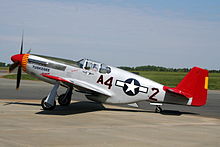 Although the Tuskegee Airmen gained a reputation for “never having lost a bomber,” a study of records later revealed that 27 of the bombers they escorted to Germany were shot down. The average for all other squadrons, however was 46, a superior accomplishment for the Red Tails. The group also shot down 103 enemy aircraft, including 3 ME-262 jet aircraft. The Black airmen proved beyond doubt that they were very capable flyers—they were awarded a total of 850 medals,
Although the Tuskegee Airmen gained a reputation for “never having lost a bomber,” a study of records later revealed that 27 of the bombers they escorted to Germany were shot down. The average for all other squadrons, however was 46, a superior accomplishment for the Red Tails. The group also shot down 103 enemy aircraft, including 3 ME-262 jet aircraft. The Black airmen proved beyond doubt that they were very capable flyers—they were awarded a total of 850 medals,
Two films have been made about the Tuskegee airmen. The first film, The Tuskegee Airmen, was an HBO film released 1995. Although the film used mostly fictitious characters, the story was considered accurate with only a few minor details concerning accuracy. (The credits at the end continued the common belief that the “Red Tails never lost a bomber.”) The film received very favorable reviews. The second movie was the George Lucas film, Red Tails. It was reviewed far less favorably, partly because of “flat characters” and aerial scenes that looked like something out of "Star Wars." (I used The Tuskegee Airmen in my classes on American history and film.)
Web sites about the Red Tails:
The Air War over Japan.
Anxious to avenge the attack on Pearl Harbor and demonstrate to the Japanese that their homeland was not safe from American attack, in April 1942 under the leadership of General Doolittle, an American aircraft carrier, the hornet, ranged far into the Western Pacific and launched aircraft in a direct attack on the home island of Japan. Sixteen B-25 bombed Tokyo and proceeded on to land in China. Very little damage was done in the raid, but it did serve to boost American morale, and alerted the Japanese to the fact that their cities were not impervious to attack from the air.
Although the bulk of American air power in the Pacific theater was used in direct support of the landings against heavily defended islands, as the war progressed and larger bombers such as the B-29 were produced, increasing attacks against Japanese cities began to do extensive damage. In those attacks hundreds of thousands of Japanese civilians were killed. Early attacks based in China proved ineffective, but when the Mariana Islands were captured by the Americans in 1944, they were used as basis from which more effective attacks could be launched against the Japanese home islands. When Okinawa was captured in early1945 extensive raids from both the Marianas and Okinawa poem of Japanese cities in preparation for the planned invasion to take place in late1945 or early 1946.
The air war over Japan culminated, of course in the dropping of the atomic bombs on Hiroshima and Nagasaki in August 1945, at last causing the Emperor to order his military forces to surrender and end the conflict. The atomic bombs were new unique in the history of strategic air warfare, in that they led directly to the desired effect: the surrender of the enemy. The extensive raids on both German and Japanese cities, however, while doing an enormous damage and causing millions of civilian casualties, failed to demonstrate the sort of results that General Douhet had predicted. See also Atomic Age section.
Air power has taken a new turn in the 21st century with the use of drones, un-piloted aircraft operated by controllers using radar who are located far from the intended targets. With radar guidance systems, they are able to pin point targets more effectively than bombs dropped from thousands of feet above their targets. The future of air power will undoubtedly continue to evolve as newer technologies are developed.
Books on the Air War:
- Jörg Friedrich and Allison Brown. The Fire: The Bombing of Germany, 1940-1945. Columbia University Press, 2008.
- Randall Hansen. Fire and Fury: The Allied Bombing of Germany, 1942-1945. New American Library, 2009.
- Barrett Tillman. Whirlwind: The Air War Against Japan, 1942-1945. Simon & Schuster, 2010,2011.
Paul Addison & Jeremy A. Crang. Firestorm: The Bombing of Dresden, 1945. Ivan R. Dee, 2006. - Frederick Taylor. Dresden: Tuesday, February 13, 1945. Harper Perennial, 2005.
- Eric M Bergerud. Fire In The Sky: The Air War In The South Pacific. Basic Books, 2001.
- Richard Overy. The Bombers and the Bombed: Allied Air War Over Europe, 1940-1945. Penguin, 2015.
- Ted W. Lawson. Thirty Seconds Over Tokyo, (Aviation Classics). Potomac Books, 2003. (Lawson was one of the pilots in Doolittle's Tokyo raid.)
An excellent film about the last days of the war, viewed from both the American and Japanese side, is Hiroshima, directed by Roger Spottiswoode and Koreyoshi Kurahara, a joint production of Canada and Japan.
| World War II Home | European War | Pacific War | Updated May 1, 2017 |